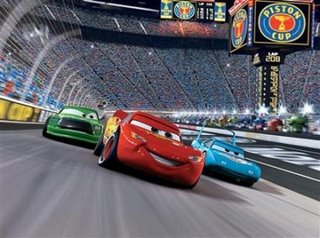
It makes me somewhat unpopular to admit that I thought that Dan Brown's novel was weak and poorly written. My problem with the novel is not with the religious controversy, but with the fact that the characters are flat, unsympathetic, and the dialogue is stiff. If you enjoyed the book I am happy for you, but I just felt differently.
When I heard that Ron Howard and Tom Hanks were involved in the movie version I immediately predicted that the movie would be better simply because Howard is a good storyteller and Hanks is a good actor. Yet, early reviews of the movie made me think my prediction was in error. After seeing the movie I can say that it is better than the book even if it is not as good as I thought it might be.
This is not Hank's best performance, however he does breathe some life into Robert Langdon's character. The movie does a magical job of showing Landgon's almost Rain-Man ability to decipher codes. Howard used a similar effect in Beautiful Mind to show the main character's ability to recognize patterns. More importantly, Langdon provides a critical element to the movie that the book does not deliver. The Dan Brown version of Langdon affirms nearly all of Leigh Teabing's conspiratorial views. But in the movie, the scene at Teabing's house is played out with more zest because Langdon doesn't accept Teabing's conclusions without debate. He dismisses the Priory of Sion and the marriage of Jesus as myth and old wives' tales. Furthermore, he accuses Teabing of interpreting facts to support his conclusions. I loved that! Even if Langdon does accept many of Teabing's conclusions, this is the sort of critical thinking I would expect from a scholar of Langdon's stature.
Likewise Teabing and Sophie are more developed characters than their presentation in the book. McKellan's performance of Teabing is witty and devious at the same time. Sophie demonstrates more distress than she did in the book. I was disappointed by Sophie in the book. She was very dull and seemed more interested in Teabing's lecture than grief over her grandfather's murder. This is not the case in the movie and Sophie shows more emotion and is not so willing to drink the Kool-Aid Teabing serves up.
Strangely enough, the most sympathetic character in the movie is Silas, the murderous albino monk. The tragic end of Silas and his devotion to Bishop Aringarosa are explained thanks to flashbacks. Is Silas an angel or a ghost? Silas is much less the cartoon villain in the book. Nevertheless, the scenes of Silas torturing himself were overdone. Silas mutilates himself - we get it!
There's one more element that not only brings more depth to the Langdon's character but it opens the door of faith. Langdon is claustrophobic because he fell down a well as a child. He admits to Sophie that he was raised Catholic and when he was in the well he prayed all night. He believes that God's presence was with him during that experience. In addition, Sophie is able to relieve Langdon's claustrophobia with a touch. We can only assume that this because she is the descendant of Jesus Christ and she has inherited a particular family trait.
Langdon leaves it to Sophie to decide what all of this means. He tells her that what matters is what she believes. Of course this falls far short of conviction and is more akin to religious relativism, but then Langdon provides a critical question for Sophie: Would the descendant of Jesus Christ destroy faith or renew it? This is a much more positive option than Teabing's plan to tear down the oppressive reign of the Roman Catholic-Vatican hierarchy.
Of course that is the only conclusion that is allowed in the novel. The goal of the Priory of Sion is to bring down the religious oppression of the Catholic church. And as we all know, every Christian on earth accepts whatever the Roman Catholic church and the Pope says without question, right? (Sarcasm Alert!). This is the un-nuanced premise that ruined the novel for me, so I was pleasantly surprised to see some nuance brought back in to the movie.
There are some that embrace the premise of The DaVinci Code for various reasons. I can certainly understand the appeal of an alternate Christianity that undermines the authority and credibility of institutional religion. (Of course there are some who simply seek to discredit Christianity and Christ altogether). However, it isn't necessary to dismantle Christology to critique ecclesiology. In fact, the best critique of errant ecclesiology is a a sound Christology that affirms the humanity and divinity of Christ along with his earthly ministry and resurrected sovereignty. A risen Christ is present with the church and is actively involved in revealing God to the church so that humanity might become more like Christ. The resurrection of Jesus is the open door of hope.
The Christology of the novel leaves us with nothing more than the reverence of dead bones. The Christology of the New Testament affirms that that which is dead can live again. The movie leaves us stuck somewhere in-between.
 "I am speed!" So goes Lightning McQueen's pre-race mantra. Lightning is on the fast lane to success and he doesn't have time to slow down for anybody.
"I am speed!" So goes Lightning McQueen's pre-race mantra. Lightning is on the fast lane to success and he doesn't have time to slow down for anybody. There's much to commend in this film. I am always impressed by the wizards of PIXAR. Every movie they've turned out has been a winner. Unlike Dreamworks, they always work from original concepts and they immerse themselves and their movies in the concepts. Be on the lookout for Click and Clack from NPR's Car Talk. There's a variety of famous race car drivers voicing characters. Cars is filled with lore about Route 66. (I am reading Grapes of Wrath and I find it interesting that both a Steinbeck novel of the Great Depression and a computer animated film about talking cars are both drawing from the significance of the Mother Road). Pay particular attention to the scene in which Sally tells Lightning how I-40 bypassed Radiator Springs to save 10 minutes of driving time. One cannot help but wonder what we have sacrificed for speed.
There's much to commend in this film. I am always impressed by the wizards of PIXAR. Every movie they've turned out has been a winner. Unlike Dreamworks, they always work from original concepts and they immerse themselves and their movies in the concepts. Be on the lookout for Click and Clack from NPR's Car Talk. There's a variety of famous race car drivers voicing characters. Cars is filled with lore about Route 66. (I am reading Grapes of Wrath and I find it interesting that both a Steinbeck novel of the Great Depression and a computer animated film about talking cars are both drawing from the significance of the Mother Road). Pay particular attention to the scene in which Sally tells Lightning how I-40 bypassed Radiator Springs to save 10 minutes of driving time. One cannot help but wonder what we have sacrificed for speed. By the way, don't rush out of the theatre when the story ends. You always want to stay until the very end of a PIXAR film and enjoy the outtakes and final scenes, but this time you should really just slow down and not be in too much of a hurry.
By the way, don't rush out of the theatre when the story ends. You always want to stay until the very end of a PIXAR film and enjoy the outtakes and final scenes, but this time you should really just slow down and not be in too much of a hurry.





